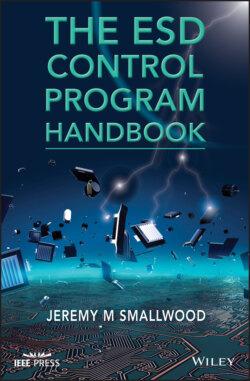Читать книгу The ESD Control Program Handbook - Jeremy M. Smallwood - Страница 45
2 The Principles of Static Electricity and Electrostatic Discharge (ESD) Control 2.1 Overview
ОглавлениеESD stands for electrostatic discharge or, according to some, electrostatic damage. This chapter provides the basis of how static electricity arises and can lead to ESD in the real world. It also provides the principles that underlie ESD control techniques and equipment design.
Electrostatic charge can build up in a variety of ways. The charged object has an electrostatic field that could conceivably lead to an ESD event in several ways:
Direct breakdown of sensitive parts due to high electric field
Generation of an ESD event directly subjecting the part to discharge currents
Generation of an ESD event subjecting a part to induced transient electric or magnetic fields, or some other stress
At the root of any ESD event there is an object or surface that has a voltage that is different to its surroundings. Without this voltage difference, no electric field is present, and no ESD current can flow. Hence, the objective of ESD prevention measures has been to keep surface voltages and electric fields to a low level, below which damaging ESD cannot occur.
A review of the explanation of electrostatic charge build‐up and ESD sources included here quickly reveals many ways in which ESD risks can be generated in the real world. These are summarized in brief in this chapter.
